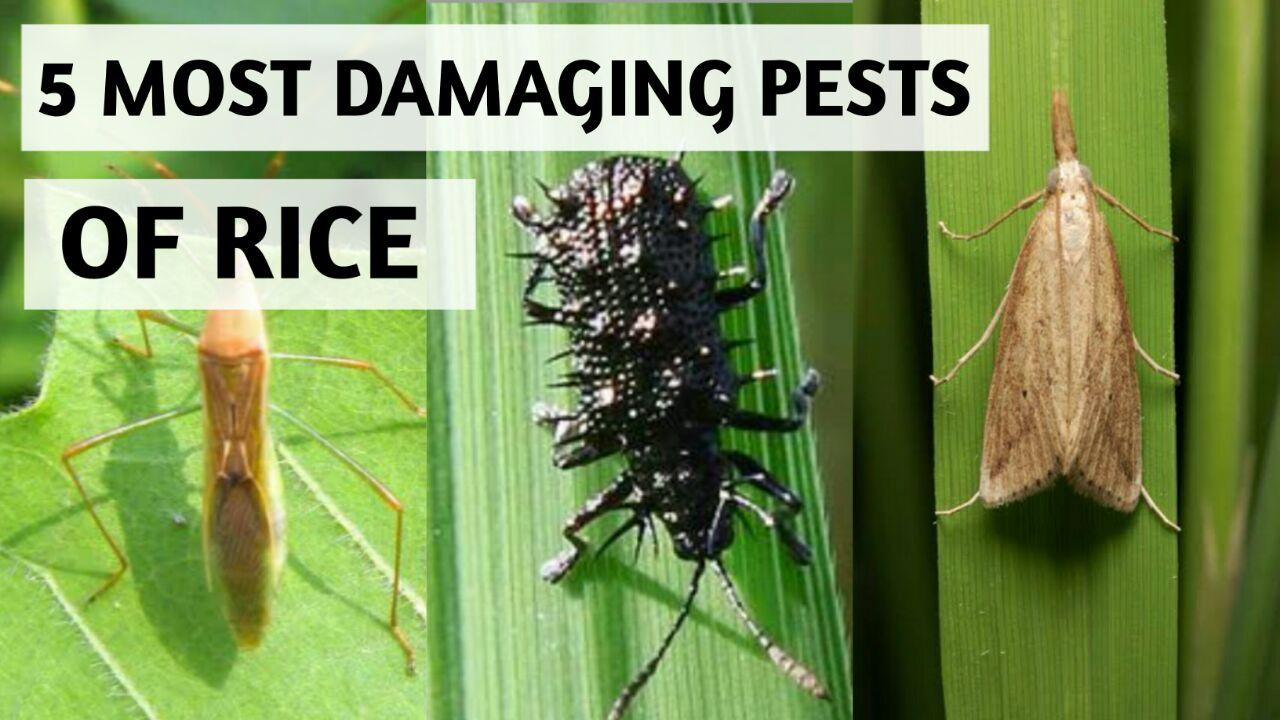5 Most damaging pests of Rice
5 MOST DAMAGING PESTS OF RICE
A. YELLOW STEM BORER – This is a monophagous insect of rice. Larvae generally hibernate in rice stubble. Yellow stem border pupates inside the plant. Adult insect have dirty white or greenish yellow front wing.
Symptoms –
1. Appearance of brown coloured egg near leaf tip.
2. Caterpillar bore into central shoot that produced ” Dead heart ” .
3. The drying of growing part of plant is known as dead heart.
4. When the entire panicle dried up that causes White ear.
Management –
1. Clip the seedlings tip before transplanting to prevent the egg masses.
2. Collect and destroy crop stubble.
3. Spray Captan hydrochloride 4G @2 5 kg/h
4. Use carbofuran 3G @ 2.5 kg/h
5. Use Fipronil 80% WG 50-60 kg/h.
B. GUNDHI BUG – The bug is about 20 mm long with calendar body and green . Egg are in oval shape and laid on the leaves in groups of 10-20. Both adult and nymph are very harmful.
Symptoms –
1. The pest has emit pungent smell that why its name is Gundhi bug.
2. In the morning adult and nymph sucks the milk of the grain.
3. Black and brown spot appears around the hole that causes shoot mold.
Management –
1. Clean field , remove all weeds.
2. Light trap is useful for capturing the adult bugs.
3. Use sweep net and dirty trap of cattle urine , dung.
4. Use Malathion 50 EC @ 2 ml/ L
5. Use resistant variety like Badshah bhog.
C. RICE HISPA – This insect is small and have blueish black in colour. It has numerous short spines on the body. The price hispa is common in rain fed area.
Symptoms –
1. Rice hispa affect the upper surface of leaves by scrapping.
2. When damage is serious plant became less vigorous.
3. Damage is done by larvae as leaf minor.
4. Affect area became whitetish in colour.
Management –
1. Float the nursery beds and then collect the battles and destroy them .
2. Do not over fertilized the field. Heavily fertilized field encourage the damage.
3. Remove any kind of weed from the field .
4. Infected leaves should be clipped.
5. Avoid excessive use of nitrogen fertilizer.
D. RICE CASE WORM – Adult moth is small , snowy white , about 6 mm long. White wing. This is a semiaquatic insect. The presence of filamentous gills helps to spend his life as semiaquatic insect.
Symptoms –
1. Larva scrapes under the leaves blade.
2. Larvae cut the leaf tip to make leaf case.
3. Leaves become whiteish.
4. The caterpillar feeds on green tissue of the leaves.
5. Floating of tubular cases on the water surface is the symptoms.
Management –
1. As we know rice case worm is a semiaquatic insect so drainage is the most effective method.
2. Add small quantity of kerosene in to the water.
3. Do good weed control.
4. Use Carbaryl dust 10 DP.
5. Use Quinalphos 25 EC.
E. RICE THRIPS – This is an important pest of rice nursery. Field that have poor water supply and lots of weed are more likely to suffer heavy damage. They have very small and thin body. Adults are dark brown.
Symptoms –
1. Infested leaves and stem shows silver mark and yellow patches.
2. Heavy attack may cause the leaves to curl at the edges.
3. The plant growth either get slower or restricted.
Management –
1. Flood the rice field for 1 to 2 days.
2. Dust the seedlings with wood ash @ 0.3 kg/m2.
3. Use Nitrogen fertilizer 0.2 kg / me.
4. Use fine net to catch the thrips
5. Use predator thrips like coccinellid beetles or anthocorid bugs as biological control.


